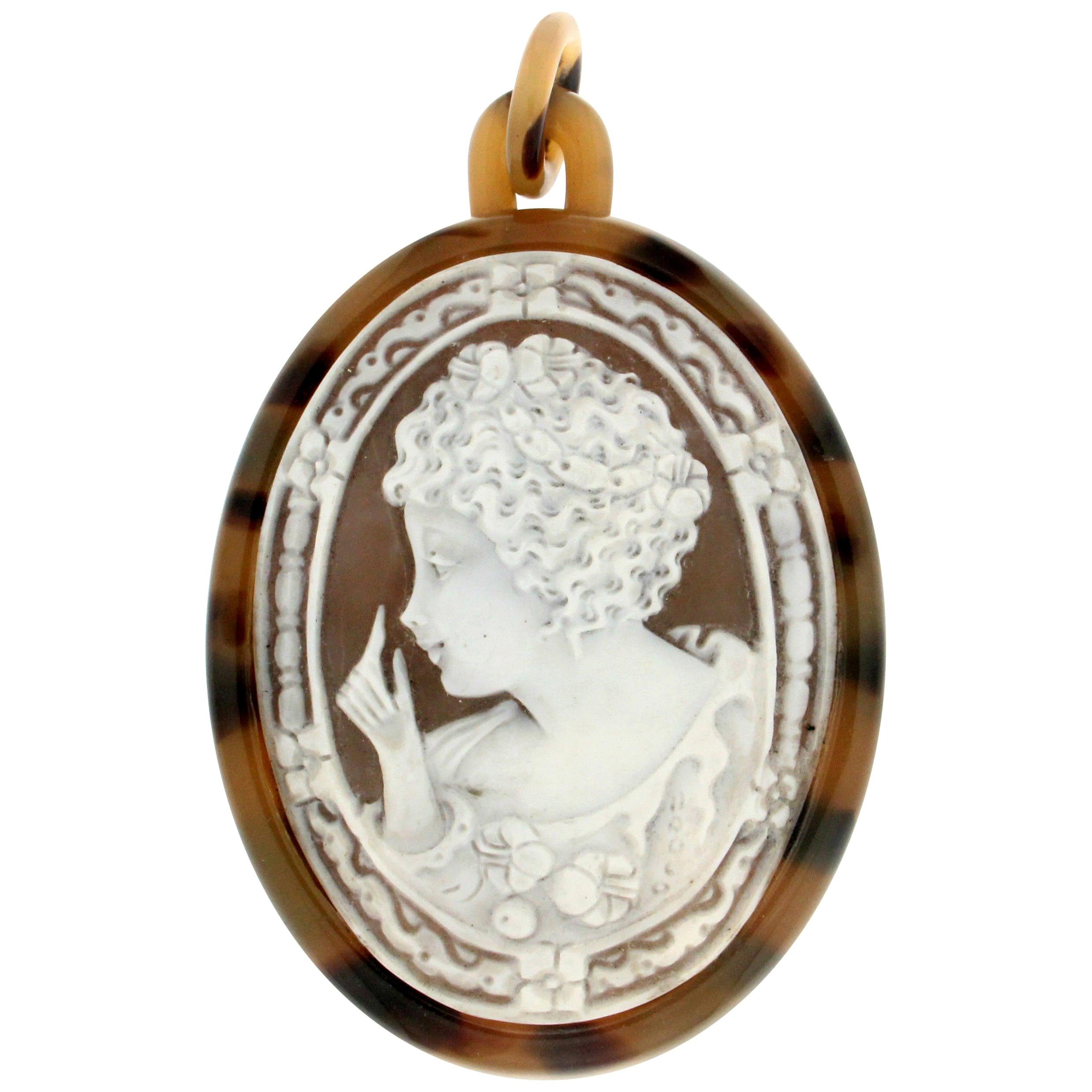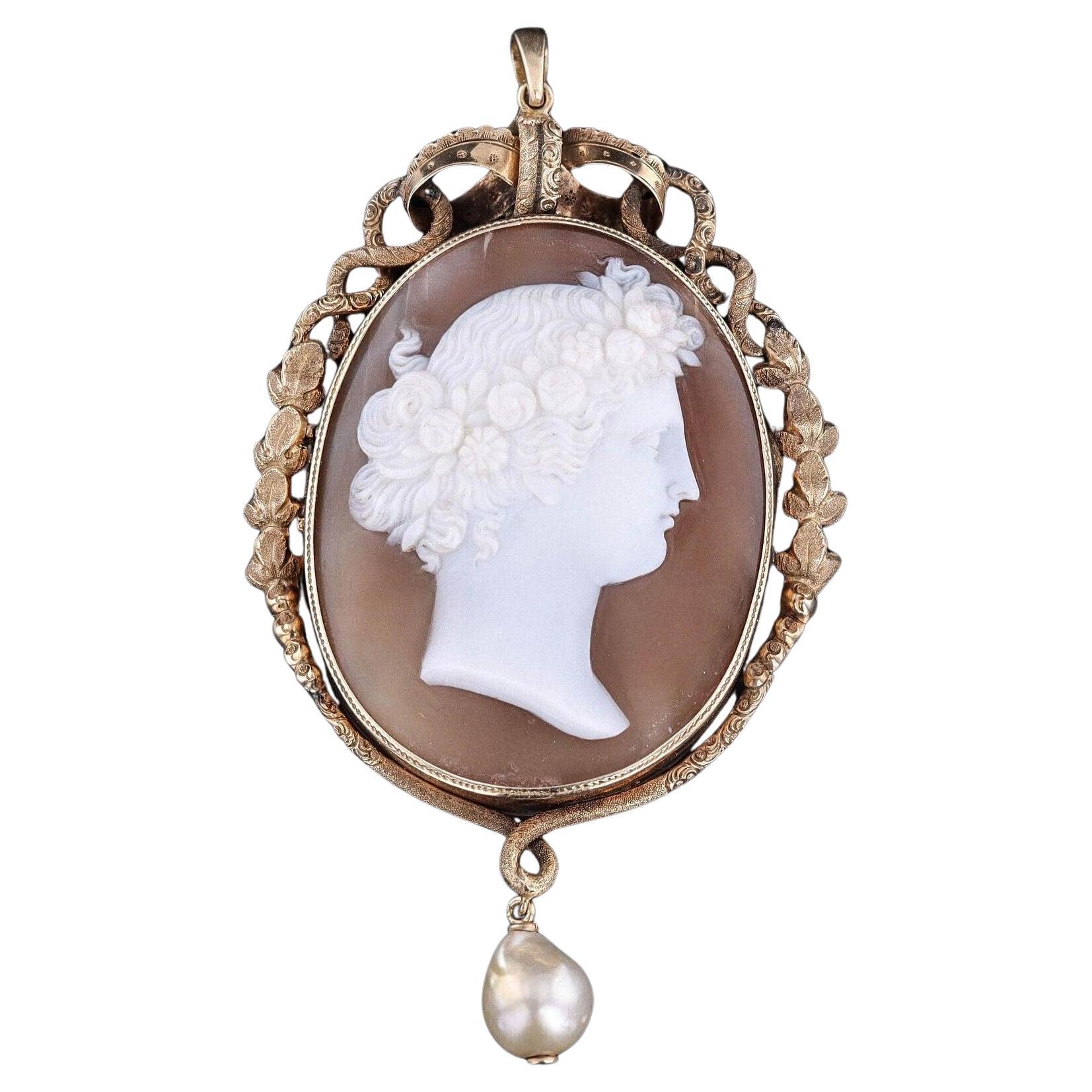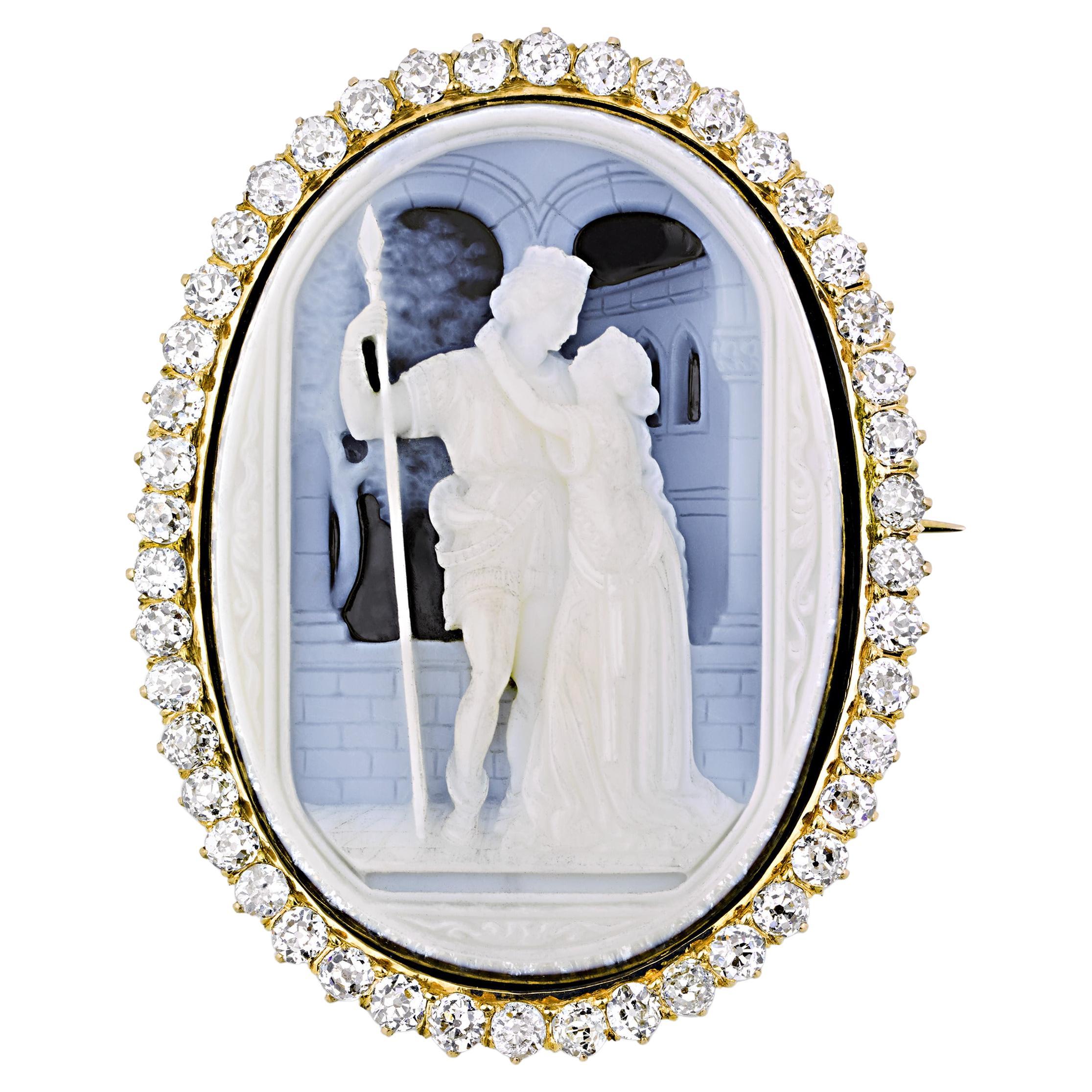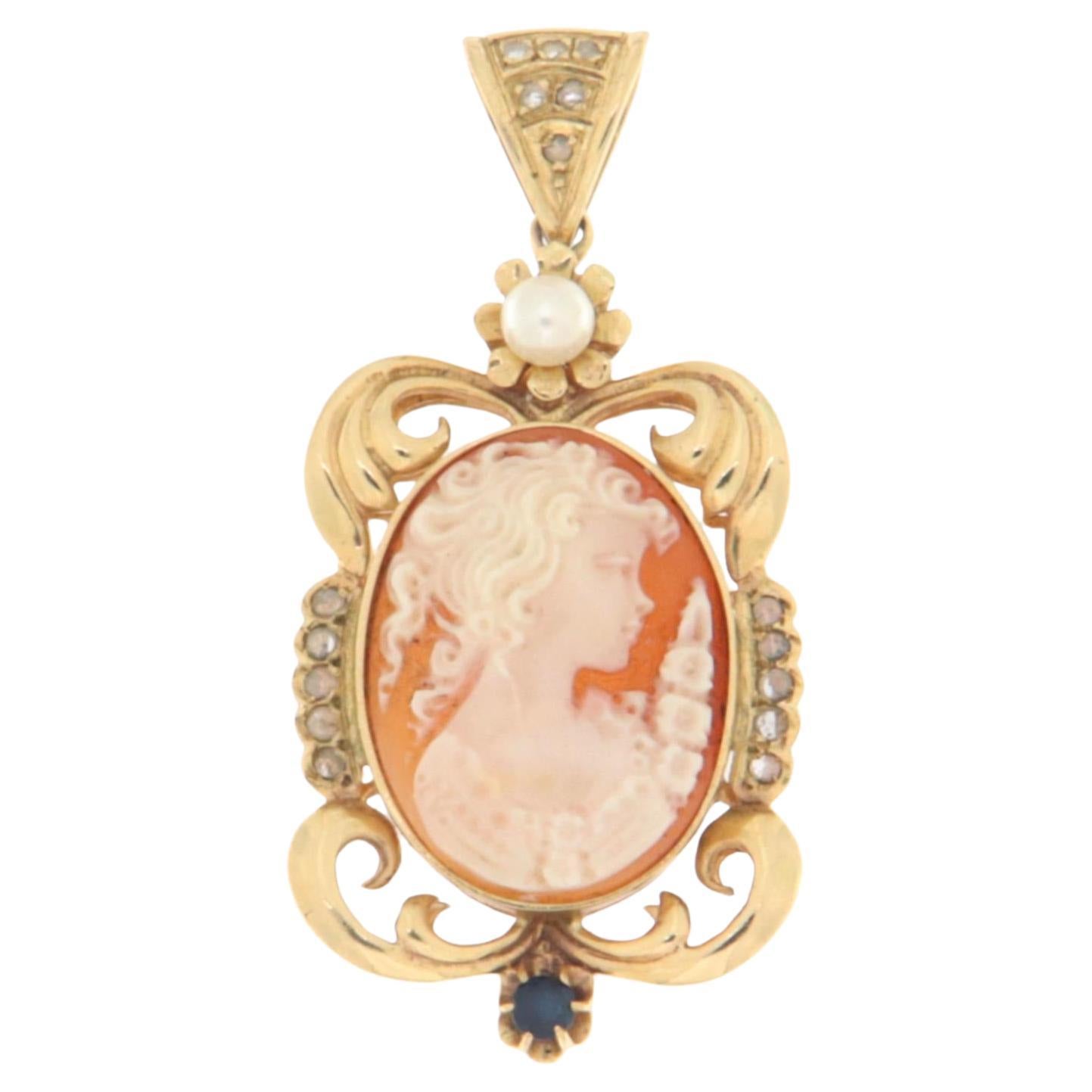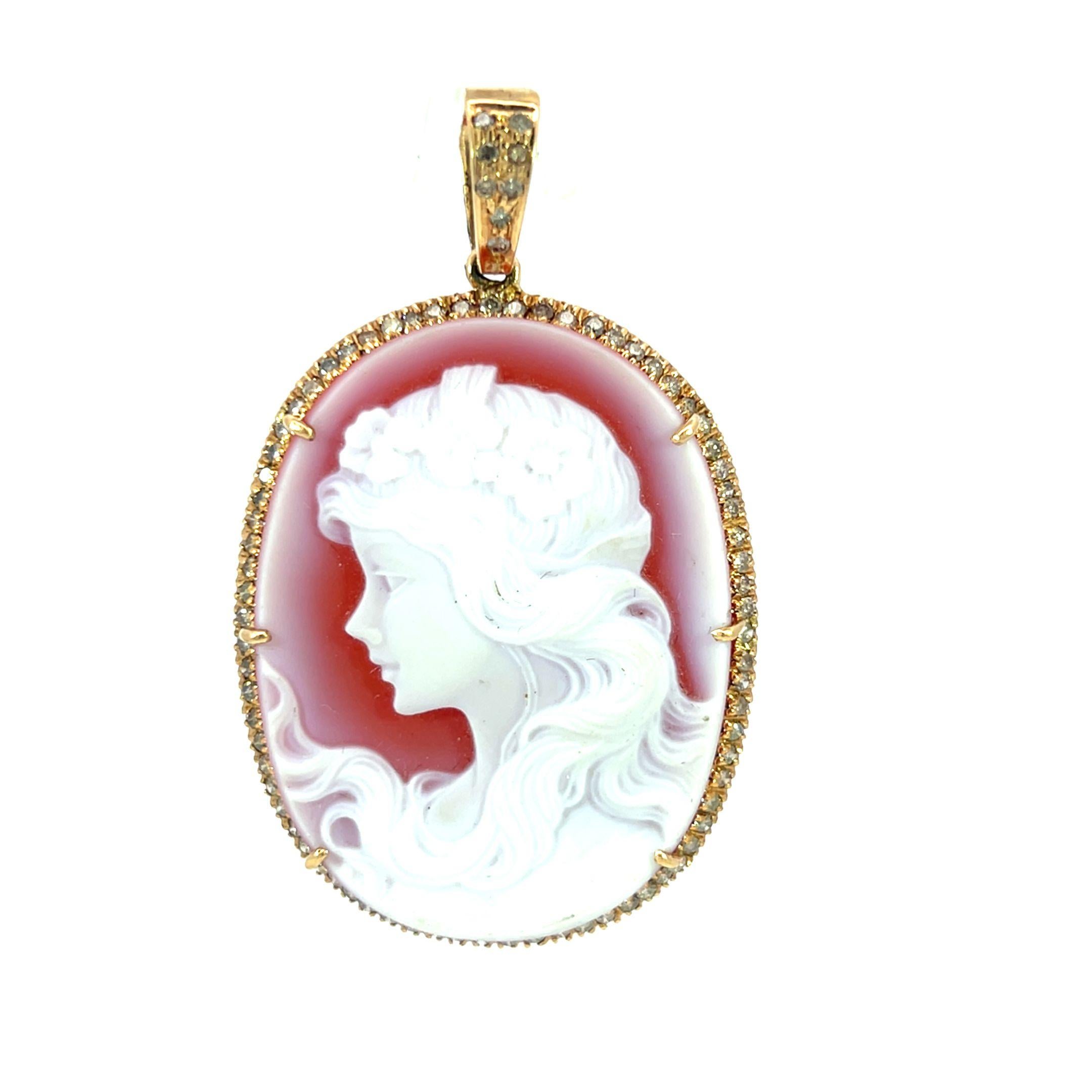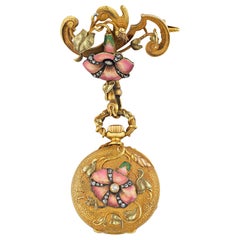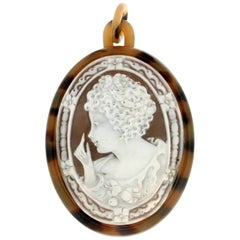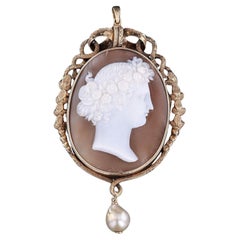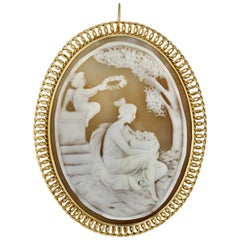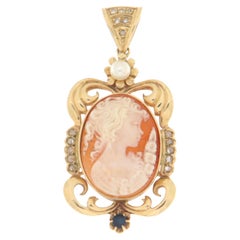Items Similar to Renaissance Cameo Pendant
Video Loading
Want more images or videos?
Request additional images or videos from the seller
1 of 7
Renaissance Cameo Pendant
$228,500
£171,028.86
€197,625.88
CA$316,853.30
A$354,916.43
CHF 184,517.09
MX$4,382,503.78
NOK 2,350,602.55
SEK 2,222,129
DKK 1,474,792.38
Shipping
Retrieving quote...The 1stDibs Promise:
Authenticity Guarantee,
Money-Back Guarantee,
24-Hour Cancellation
About the Item
The cameo at the center of this exceptional pendant is a stunning example of the art of gem engraving during the Renaissance. It likely dates to the early 17th century and features a sacrificial scene inspired by the Greco-Roman era. The central flaming altar is flanked by two figures preparing to sacrifice a ram, while a figure in a lion skin blowing horns stands in the left corner. The carver brilliantly uses the natural layers of the stone to achieve the illusion of shadow and musculature on the figures. A second, smaller cameo is set at the top of the pendant, while a myriad of multi-colored gems, pearls and enamel adorns the 18K gold setting. A large Baroque pearl suspended from an enamel dragon finishes the design, which embodies the opulence and theatricality of jewels from the Renaissance age.
Cameos and intaglios were highly popular amongst wealthy connoisseurs in Renaissance Italy, and owning the finest pieces was the privilege of princes. Although they were often elaborately mounted for display alone, cameos were also frequently worn as pendants, surrounded by enameled and stone-set gold frames. Such pieces were particularly prized by the Medici and Lorraine families, many of which can now be seen at the National Archeological Museum in Florence.
Very few Renaissance cameos remain in existence and even fewer in such elaborate pendant settings. The present example is among these rarities, while others can be found in the British Royal Collection and the Metropolitan Museum of Art.
Cameo: Early 17th century
Pendant: 9" high x 5" wide
14K gold chain: 16" length
- Metal:
- Stone:
- Stone Cut:
- Dimensions:Height: 9 in (228.6 mm)Width: 5 in (127 mm)Length: 16 in (406.4 mm)
- Style:Renaissance
- Place of Origin:
- Period:
- Date of Manufacture:Early 17th Century
- Condition:
- Seller Location:New Orleans, LA
- Reference Number:Seller: 30-83941stDibs: LU13510031212
About the Seller
5.0
Recognized Seller
These prestigious sellers are industry leaders and represent the highest echelon for item quality and design.
Established in 1912
1stDibs seller since 2010
31 sales on 1stDibs
Typical response time: 8 hours
- ShippingRetrieving quote...Shipping from: New Orleans, LA
- Return Policy
Authenticity Guarantee
In the unlikely event there’s an issue with an item’s authenticity, contact us within 1 year for a full refund. DetailsMoney-Back Guarantee
If your item is not as described, is damaged in transit, or does not arrive, contact us within 7 days for a full refund. Details24-Hour Cancellation
You have a 24-hour grace period in which to reconsider your purchase, with no questions asked.Vetted Professional Sellers
Our world-class sellers must adhere to strict standards for service and quality, maintaining the integrity of our listings.Price-Match Guarantee
If you find that a seller listed the same item for a lower price elsewhere, we’ll match it.Trusted Global Delivery
Our best-in-class carrier network provides specialized shipping options worldwide, including custom delivery.More From This Seller
View AllDiamond Cameo Pendant, 4.50 Carats
Located in New Orleans, LA
Featuring a combination of both exquisite intaglio and relief carving, this cameo pendant combines the glory of the Classical age with the refinement of the Victorian era. The pendan...
Category
Antique 19th Century Victorian Pendant Necklaces
Materials
Diamond, 18k Gold, Yellow Gold
Antique Moses Cameo Brooch
Located in New Orleans, LA
The legendary Michelangelo's Moses is meticulously recreated in this 19th-century cameo brooch. Crafted of beautiful onyx, the intricate cameo resides in ...
Category
Antique 19th Century Unknown Victorian Brooches
Materials
Diamond, Pearl, 18k Gold, Yellow Gold
French Cameo Brooch
Located in New Orleans, LA
Exuding the elegance of the Victorian era, this exquisitely carved French agate cameo features a neoclassical maiden in profile, adorned with a delicate floral crown. Her serene expr...
Category
Antique 19th Century French Victorian Brooches
Materials
Agate, Diamond, 18k Gold
French Art Nouveau Watch Pendant
Located in New Orleans, LA
This beautiful French watch pendant features a sublime, organic floral motif indicative of Art Nouveau jewelry design. Crafted of 18K gold, this elegant timepiece is enveloped in graceful angel...
Category
Antique 19th Century French Art Nouveau Pocket Watches
Materials
Diamond, 18k Gold, Enamel
Patek Philippe Edwardian Pendant Watch
By Patek Philippe
Located in New Orleans, LA
Exquisitely crafted by Patek Philippe, this rare Edwardian Belle Époque pendant watch exemplifies the height of Swiss artistry and design. The caseback is adorned with rich purple gu...
Category
20th Century European Edwardian Pendant Necklaces
Materials
Amethyst, Diamond, Platinum
First Empire Napoleonic Portrait Necklace
Located in New Orleans, LA
Extraordinarily rare and steeped in imperial symbolism, this First Empire sautoir captures the grandeur of Napoleon Bonaparte's reign. Crafted in rose gold, the articulated necklace ...
Category
Antique 19th Century French Neoclassical Pendant Necklaces
Materials
Carnelian, Rose Gold
You May Also Like
Handcraft Cameo Galalith Pendant Necklace
Located in Marcianise, IT
For any problems related to some materials contained in the items that do not allow shipping and require specific documents that require a particular period, please contact the seller with a private message to solve the problem.
Cameo mounted with galalith pendant...
Category
Vintage 1970s Italian Artisan Pendant Necklaces
Antique Shell Cameo Pendant of 12k Gold
Located in Lewisburg, PA
This antique pendant (circa 1870) features a carved shell cameo of a beautiful woman set in 12k gold with a fresh water pearl dangle.
The piece measures 3.3 inches from the top of t...
Category
Antique Late 19th Century Pendant Necklaces
Materials
Pearl, Gold
Gold and Cameo Brooch, Depicting a Neoclassical Scene
Located in Palm Beach, FL
A Gold and Cameo Brooch, depicting a neo-classical scene in a decorative 14 kt gold foliate frame, brooch fitting, pendant hook
2.25 in. (5.71 cm.)
Category
20th Century Pendant Necklaces
Materials
Gold
Cameo Sapphire Diamonds Pearl 12 Karat Yellow Gold Pendant Necklace
Located in Marcianise, IT
This elegant 12-karat yellow gold pendant is a timeless piece of jewelry that exudes sophistication and charm. At the heart of the design is a finely hand-carved cameo, depicting the...
Category
Vintage 1980s Italian Artisan Pendant Necklaces
Materials
Diamond, Pearl, Sapphire, Yellow Gold
Beautifully design natural Cameo pendant with diamonds
Located in New York, NY
This gorgeous 18-karat natural 36.45-carat cameo pendant has a wonderful oval shape set in a delicate gold setting with 1.04-carat diamonds all around it. Its striking hue and sophis...
Category
21st Century and Contemporary Pendant Necklaces
Materials
Diamond, 18k Gold, Yellow Gold
Goddess Cameo Pendant Brooch Necklace 18 Karat Gold Classical Antique 2.5 Inches
Located in New York, NY
This is an absolutely stunning and very rare large antique Shell Cameo Pendant Brooch with a hand carved image of a Goddess Maiden standing ...
Category
20th Century Italian Victorian Pendant Necklaces
Materials
Gold, Yellow Gold, 18k Gold
More Ways To Browse
Medici Gold
17th Century Pearl
Altar Stand
Lion Dragon
Stone Altar
Medici Lion
Medici Jewelry
Renaissance Cameo Pendant
Illusion Pearl Necklace
Medici Family
Pomellato Coral
Poppy Necklace
Rough Lapis Lazuli
Ruby Invisible Set Pendant
Russian Guilloche Enamel Egg Pendants
Spider Web Necklace
Starburst Locket
Terrier Pendant
